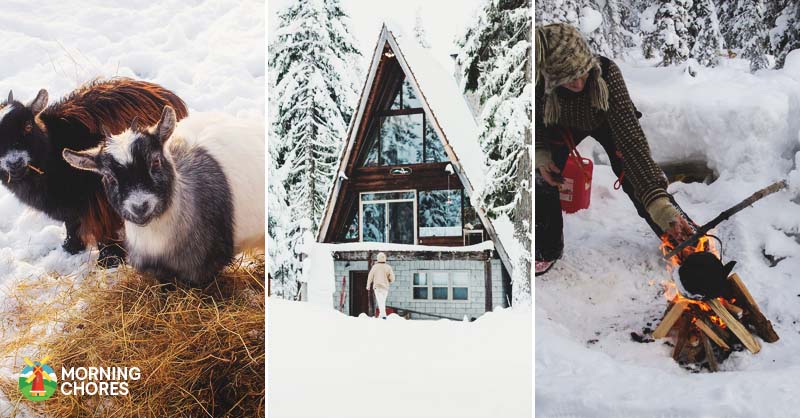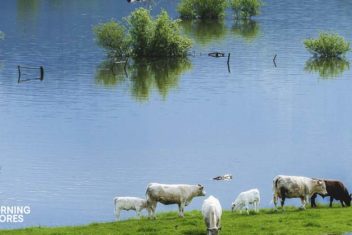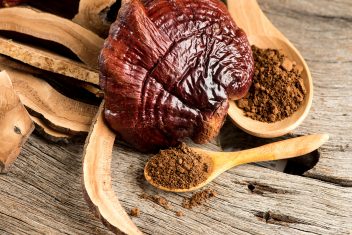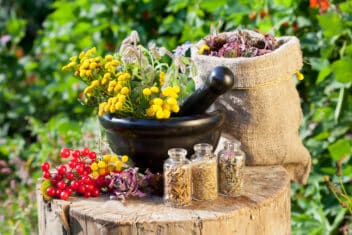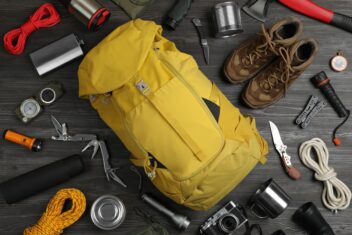A few days ago my life was completely normal. I was outside working on our property. The wind was cold, but nothing else was out of the ordinary. Then I began hearing on the news that a winter storm was heading for our state, but we would be completely missed by it.
So I thought, “Okay” and went on about my business.
The next morning I woke up and went about my business as I would any other morning. So I took a shower. And when I came out of the bathroom, it was flurrying. By the time I finished getting ready, it was downright snowing.
By the end of the afternoon, schools had been let out early, we had a few inches of snow on the ground already, and the weather people were saying that winter storm was right over on top of us.
It wasn’t too long after that I was seeing posts on social media that power outages were happening, roads were slippery, and people were panicking.
Lesson learned you can’t perfectly predict where the storm would be heading. So it’s better to always be prepared, just in case.
Here’s how to get prepared for storm:
1. Get Your Blankets Out
Winter storm could come early in the winter or even in the late fall. If you love the cold weather, enjoy lower electricity bills because you won’t use the heater unless you have to, then you should have blankets prepared early every year.
You want to make sure that you have plenty of blankets that you can use to keep yourself and loved ones warm in a winter storm. If your power goes out, they may help you to stay warm especially if you don’t have an alternative heat source.
2. Have Emergency Light Sources
Next, make sure that you have and know where your lanterns and flashlights are. Make sure that they are in working order, and that you have plenty of batteries for them in case you have to use them for days on end.
Between the weight of the snow, the ice, and the high winds, power lines struggle to keep up. So when winter storms hit, it usually takes out your power too.
Plus, it gets dark a lot earlier in winter so you need a light that can last longer since you’ll spend more time in darkness during winter power outages.
3. You Might Need an Alternative Cooking Method
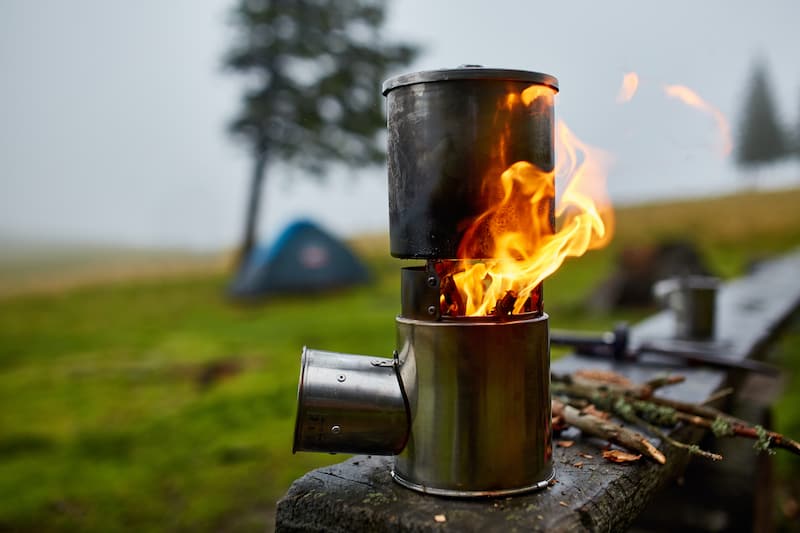
If you have power when the storm hit, then great, you can continue cooking normally. However, if your power goes out, then you need to stockpile lots of bread and peanut butter, otherwise, you might become hungry very quickly.
That’s why it’s nice to have an alternative cooking source. If you have an alternative heat source like a wood stove or fireplace, you may be able to cook on it.
However, if you don’t, then you may want to think ahead so you can have a place to cook on your grill or even create an outdoor kitchen. You could also utilize a rocket stove or some of these off-grid cooking methods. However you choose, just make sure you have a way to prepare food that does not require electricity.
4. Make Sure Your Animals are Warm
Humans are not the only ones feeling the cold. Pets and farm animals feel the cold too, even with all the furs and feathers on their body.
Make sure you have plenty of straw and/or hay for your farm animals. They can use this as extra insulation for their bedding. For pets, keep them indoors with you and prepare some pet clothes if needed.
Animals eat a lot to stay warm in a winter storm so provide plenty for them to munch on.
Lastly, give all of your animals a place to get out of the elements. It doesn’t have to be perfect, but they’ll need a place to go that will break the wind and keep the moisture off of them.
5. Stockpile Animal Feed
We actually ran into this problem ourselves when this storm popped up out of nowhere. We have recently moved to a larger chunk of land so our goats are out on pasture now.
However, we didn’t think what it would be like if the pasture was covered in snow. The goats managed to dig out food under the snow, but we had to go out in the weather before everything closed to buy last-minute feed to make sure they didn’t get hungry.
So you’ll want to do the opposite of what we had to do and be prepared. Be sure to keep a stash of hay, livestock feed, and any other grains that your animals may need just in case they can’t graze like they normally would because of weather.
6. Plenty of H2O
No matter what disaster you face, it is always a great idea to keep a stockpile of water for both you and your animals. We do this by storing water in the barrels that we harvest from the rain. This is a great way to recycle rainwater and keep our animals watered without using our well.
However, for us, I usually refill milk jugs and store them with plenty of water.
Still, if you know that a storm is coming your way, it is always a good idea to fill up your washing machine and bathtub with water so you’ll have water to drink and flush your toilet with if you are not on city water.
7. Plenty of Food for You
Next, you’ll want to make sure that you have plenty of food stored for you and your loved ones. You can either do this by heading to the grocery store as soon as you hear that a winter storm is headed your way.
However, just be advised that the stores get crazy. I was actually out of milk the day this storm came in on us, and I found myself scurrying to the store to grab a gallon or 2 before everything closed. Did you know there were only 3-gallons left on the shelf?
And I wasn’t that slow at getting to the store. So it is always a good idea to keep lots of non-perishable items on your shelves in case things change quickly, and you can’t get to the store as planned. This is where canning comes in handy, which we do a lot of. It is cost-effective and then we know we always have food.
8. Keep the Water Running
In the previous home that we owned, every time the temperatures dipped down to freezing the pipes would freeze. It would help to leave the water dripping, but it wasn’t always a foolproof plan.
So if you have sensitive pipes, then it might be a good idea to keep those water lines thawed (or at least attempt to keep them thawed) by leaving a slow drip on your faucet.
Keep in mind, you don’t have to keep a stream running. However, a slow drip should hopefully keep water moving through the pipes so they won’t freeze. The idea is to avoid as few hurdles as possible when the elements are a little harsh around your farm.
9. An Outdoor Heat Source
I had a lot of friends texting me telling me that their power was out overnight. They were cold and frustrated because their homes had no alternative heat source.
So obviously, I highly recommend installing an alternative heating source in your home such as a wood stove. Our previous home had one, and we haven’t had the chance to install one at our new property yet.
However, after this storm has rolled through, we realize just how much we miss the warmth of wood heat and will be adding one very soon!
Yet, if you don’t have an alternative heat source indoors, you can create one for the out of doors. A good idea would be to create a burn barrel so you can light it and be able to get warm in front of it if you are really feeling the chill in a house with no power. You could also create a fire pit that could create warmth for you as well.
10. Gas for Your Car
You may be thinking, “Why would I drive anywhere in a winter storm?”
Well, you wouldn’t hopefully. This idea isn’t meant for you to drive. It is meant for people who are without power, have no alternative heat source for the indoors or out of doors either.
So you can gas up your car and when you are really cold, you can go turn your car on and utilize the heat it provides.
Now, I must remind you, only do this outdoors. Do not leave your car running in a closed garage or anything like that because of the effects of breathing in carbon dioxide and being poisoned. It can seep into your home as well.
So if you are going to use your car for heat, be sure that there is plenty of ventilation so you don’t become ill or worse.
11. Portable Charging Station
Something I always do when I know bad weather is upon us is to pull out my portable chargers and prepare them to be plugged into my car.
See, when you work from home, you really have no excuse nowadays to not work. This means I have to be able to keep my phone charged so I can use it as a viable internet source, and I have to keep my computer charged so I can work on it.
Not to mention, work can keep you from going stir crazy when you are trapped inside your home because the weather is too bad to be outside.
So if you work from home or just need a way to keep your phone charged to keep in touch with others in case of an emergency, then you’ll need to make sure that you have a car charger or another portable charger that will keep your devices running even when the power is out.
12. Secure Your Windows and Doors
Finally, you’ll need to stop all drafts from coming into your home via your windows and doors. These cold winds slipping through those two places can keep your home chilled. This is a problem if you have working heat, and this is a definite problem if you have no heat working in your home.
So you’ll want to be sure to put towels at the base of your doorways to stop any draft from coming in that way.
Plus, you’ll want to make sure that you have a good amount of weather stripping applied to your windows to seal them uptight.
13. Salt, Salt, Salt
We have salt, thankfully. We also have a snow shovel that could be easily accessed.
Now, does this mean that anyone actually thought enough ahead of time to utilize the salt? Actually, no we didn’t.
As I said, this snowstorm was not supposed to be here and then BAM! It was here. So tomorrow’s game plan is to use the snow shovel so I can stop slipping and sliding all over my front porch every time I take the dogs out to the bathroom.
Seriously, I’m lucky I’m not at the ER yet. I don’t want that fate for you all either. So before the snow hits, stock up on salt and know where your snow shovel is.
Then don’t be afraid to utilize it so you don’t have an ice rink on your front porch. If you’d rather try the DIY method, here is a great resource for all sorts of DIY ice melters. We have a resource for your car windshields too.
14. Snow Gear
You guys are going to laugh at me, but I wasn’t prepared for winter weather to start this early. I live in the south for crying out loud. There are some winters we’ll get 20-inches at a time (that happened a couple of years ago), and then there are winters we’ll get nothing…not even a dusting.
So I wasn’t prepared for heavier snow before the official start of winter. This means when my youngest child said, “Mom, I want to build a snowman!” I was totally unprepared. We just moved to our new home 6 months ago, and if I’m honest, I’ve crammed certain things I wasn’t using immediately in places just to get them out of the way while I get the house settled.
This means I have no idea where the gloves, scarves, or snow boots are at the moment. I have a few ideas, but nothing I could act on immediately and produce them in the amount of time my son would be content with.
So guess what? He played outside in the snow with multiple layers of pants, multiple layers of sweatshirts with a jacket, socks on his hands for gloves, and plastic grocery bags tied around his shoes. He didn’t complain, he actually complimented me on how well it worked.
However, hopefully, by the next snow, I’ll be a little more prepared and actually know where our snow gear is. I recommend you get a jump on that too so your kids don’t build a snowman with wool socks on their hands and plastic bags over their shoes. My older son looked at me and said, “Mom, what if someone sees me?”
Thankfully, we had no random guests in a snowstorm while my kids were building a snowman. (Teenagers…)
15. Keep Your Animals’ Water Thawed
One of the biggest hassles of living on a farm in the winter is that even when the temperatures are frigid you have to get out in them. Why?
Well, because you have to make sure that your animals have water and that it stays thawed.
Now, you can buy chicken waterers that are heated, but what about your other livestock? One of the best solutions I’ve ever heard of is putting their water tub inside large tires. The rubber from the tires keeps the water from freezing.
Otherwise, you can do what I’ve done many a winter. That is I trek through the snow in boots with a hatchet. I use the hatchet to bust through the ice and dump fresh water on it. You can also add a small amount of salt to the water to try to deter the ice as well.
However, not too much. This could dehydrate your animals or deter them from drinking the water altogether.
However, your animals’ bodies are working overtime to stay warm in the harsh weather so water and keeping them hydrated is very important.
Well, you now have 15 tips to think over before your next winter storm comes along. Thankfully, this winter storm has almost left us, but we are still dealing with below zero wind chills and icy roads.
However, I hope to be a little better prepared the next time around. Hopefully, this list will help you be better prepared too.
If you need some ideas on winter power outages, you can check out some of our winter power outage tips here.
